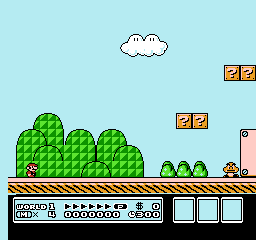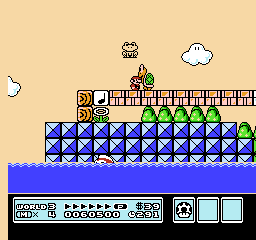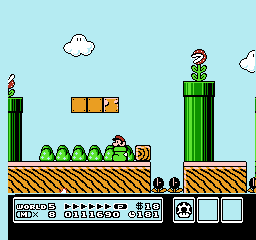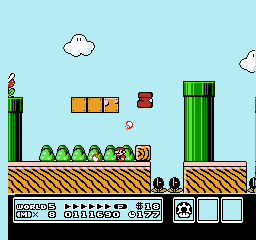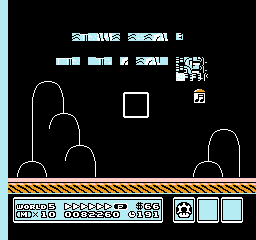Super Mario Bros. 3/Различия между версиями
Это доп. страница статьи Super Mario Bros. 3.
Что нужно:
|
Contents
Изменения "Япония-США PRG0"
Чуть-чуть было изменено за 2 года между японской и международной версиями игры. Интересно, что версия игры, включённая в Super Mario All-Stars (и, в добавок, Super Mario Advance 4), поимела перемешивание и соответствие с различными изменениями.
Главный экран
| Япония | Международная |
|---|---|
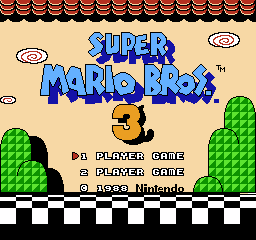 |
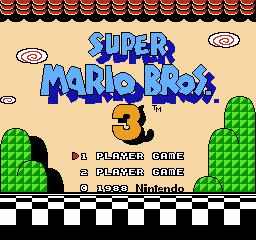 |
Товарный знак был переставлен в международной версии, но вернулся на своё место в All-Stars. Пол также находится на одну строку ниже из-за некоторых изменений в коде MMC3 IRQ, делая верхний ряд белых пикселей появляться правильно.
Gameplay and Visual Changes
| Japan | International |
|---|---|
An extremely minor change, but the "WORLD" text in the hud during gameplay had an erroneous missing pixel in the Japanese version (although the version of it used on the world map hud is completely fine), which was fixed in the US version.
Интро уровня
In the Japanese version, a fade-in effect starts when the level appears, similar to the fade-out that normally occurs on the map screen when you enter a level. This fade-in was cut out for the international versions, which reduces the wait time by around one second per level. All-Stars uses a similar fade-in, though much smoother thanks to the SNES' Mode 7 capabilities.
Damage System
By far the biggest change between versions. In the Japanese version, getting hit while powered-up causes the player to shrink to Small Mario just like in the first two Super Mario Bros. games. Apparently this was deemed too hard for overseas players, so it was changed: Anything above Super Mario reverts only to Super Mario when hit, then to Small Mario. While Super Mario World went back to the Japanese system, this revised system became a series standard following New Super Mario Bros., and it was also retained in All-Stars. This change makes the short demo that plays on the title screen that explains the general physics of the game "incorrect" in the international versions as Mario is clearly shown being reduced to Small Mario when being hit by a shell when he is Raccoon Mario, something that, bizarrely enough, was not fixed for either All-Stars or Advance 4.
Losing Powerups
In the Japanese version, getting hit as Fire or Raccoon Mario will play the same animation as getting hit as Super Mario. With the new damage system, the International version now has the powerup disappear in a puff of smoke when getting hit while powered-up above Super Mario, using the same animation as getting a Super Leaf or a Frog, Tanooki, or Hammer suit in all versions of the game.
If you get hit while wearing any of the 3 suits in the Japanese version, the suit flies off and makes this sound effect.
This was removed in the International version, with the animation now being the same as getting hit while Fire or Raccoon Mario, as mentioned above. All-Stars changed these animations, now having the player flash if they get hit as Fire or Raccoon Mario, using the same sound effect as getting hit as Super Mario, while reinstating the suit damage effect from the Japanese version. The unused sound was later used in Super Mario Maker when losing the Goomba Shoe, and Super Mario Maker 2 when losing the Frog Suit respectively.
The Japanese version treats Goomba's Shoe the same way as any other suit, in that getting hit sends the shoe flying off and reverts you to small Mario. The international versions retain the visual effect (and correct the shoe color from red to green), but let you keep your current powerup. This change was retained in All-Stars.
Mushroom House Waiting
In the Japanese version, the player can move before Toad is done talking. In the international versions, the player must wait until the message is completely displayed. Another change reverted for All-Stars (With Advance 4 further tweaking it by completely removing the waiting time).
Изменения в дизайне уровней
World 1 Fortress
| Japan | International |
|---|---|
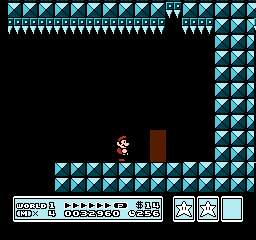 |
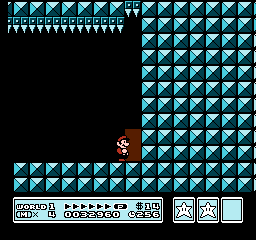 |
The spike room of the World 1 Fortress was changed. The spikes no longer continue past the door, and the gap is now right where the door is. This made the part slightly easier. This change was retained in All-Stars.
King's Chamber
| Japan | International |
|---|---|
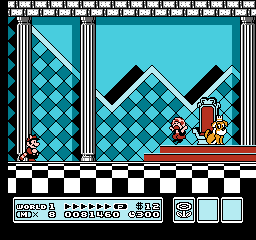 |
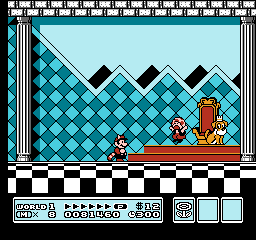 |
The king's chamber underwent a remake in the international versions. The background was brightened, the cyan stairs and throne were changed to a more royal-looking gold, and the stairs were lengthened slightly. The pillar's shadows were mirrored (which caused them to be inconsistent with the background triangles' shadows), the triangles in the background were changed, and the rightmost pillar was moved in front of the stairs. Finally, Mario stands in front of the stairs, instead of on the left side of the screen. You might've also noticed that the middle pillar was removed, and that's because...
| Japan | International |
|---|---|
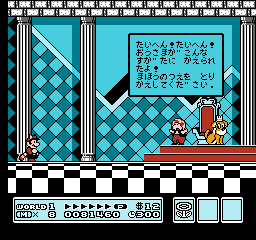 |
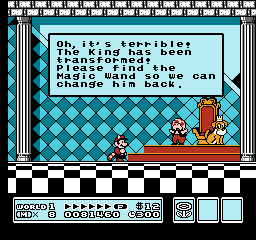 |
The text box was expanded to fit the translated text, which meant it would've overlapped with the pillar. It also became brighter like the background.
All-Stars использует японскую вариацию.
Minigame Cutscenes
| Japan | International |
|---|---|
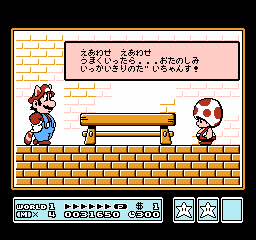 |
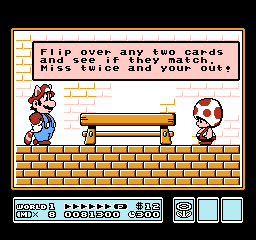 |
On that note, just like the text box in the king's chamber, the text box seen during the minigame cutscenes was widened to accomodate for the English text.
World 5-1
| Japan | International |
|---|---|
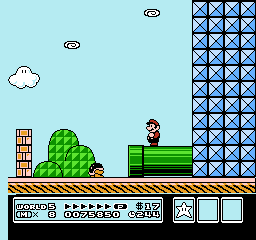 |
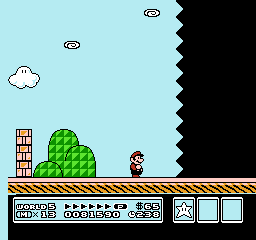 |
In the Japanese version, 5-1 ends in a pipe which you have to enter to get to the final area. In the international versions, the pipe and a Buster Beetle were removed and the level leads seamlessly into the black area. This was done to fix a weird bug that happened if you used a P-Wing to fly over the blue structure at the final area (see Bugfixes). All-Stars retained this change.
World 6 Mushroom House
The first Mushroom House in World 6 contains a Hammer Suit in all 3 chests in the Japanese version. In the international versions, it was changed to randomly give you a Super Mushroom, Fire Flower, or Super Leaf. All-Stars reverted this change.
World 8 Battleship Level
| Japan | International |
|---|---|
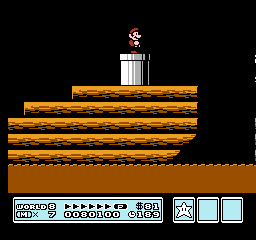 |
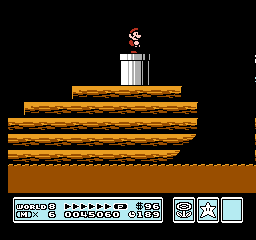 |
In the international versions, one tile was removed off the end of the final ship, allowing players to more easily jump onto the ship should they swim under the fleet. In the Japanese version, the jump must be timed with the ship's wavy motion. All-Stars, oddly enough, reverted this change.
Изменения в тексте
Помимо переименования Princess Peach в Princess Toadstool, в локализации были сделаны несколько изменений.
World 3 and 5 Hints
In the international versions, the hints the Princess gives you in her letters received at the end of Worlds 2 and 3 switched places with each other in the localization process. This would later be corrected in Advance 4.
| Japanese Script | Literal Translation | English Script |
|---|---|---|
しろいぶろっくは てきを けちらす まほうの ちからがあるそうよ. |
It seems that the white block is imbued |
You can stomp on your enemies using Kuribo's shoe. |
At the end of World 2 in the Japanese version, the Princess gives you a hint about the white blocks that are first encountered in World 3.
| Japanese Script | Literal Translation | English Script |
|---|---|---|
くりぼうのくつをつかうと いろんなてきを ふみつけられるのよ. |
You can trample various enemies |
The White Block contains magic powers that will enable you to defeat your enemies. |
At the end of World 3 in the Japanese version, the Princess gives you a hint about Kuribo/Goomba's Shoe encountered in World 5.
Ending
| Japanese Script | Literal Translation | English Script | Super Mario Advance 4 (US/EU) |
|---|---|---|---|
ありがとう! やっと きのこのせかいに へい わがもどりました. --------------------- おしまいっ! |
Thank you! At last, peace has returned to the Mushroom World. --------------------- The End! |
Thank you. But our Princess is in another Castle!...Just kidding! Ha ha ha! Bye bye. |
Thank you! Peace has at last returned to our fair Mushroom Kingdom! |
In the original Japanese version, Peach delivered a more generic "Peace has returned to the world" line, while in the international version, her line was changed to a jokier "Your Princess is in another castle" gag. The International versions of All-Stars retain this edit, while the International versions of Advance 4 use a line that's more accurate to the Japanese one, but refers to the Mushroom Kingdom instead of the Mushroom World.
Ending Curtain Speed
After the curtains close, it takes a moment longer for them to rise again during the Japanese ending.
Наименование мира 8
| Япония | Международная |
|---|---|
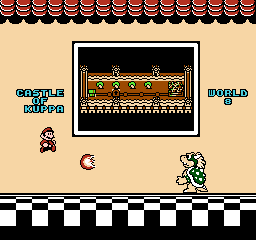 |
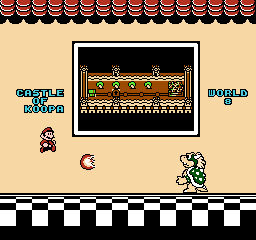 |
The Japanese name of World 8 is "Castle of Kuppa", using an alternate English spelling of Koopa sometimes used in Japan during this time. It was changed to the more standard "Castle of Koopa" internationally. All-Stars uses the International spelling in all versions.
28 P-Wings
In the international versions of the game, pressing Start after the ending sequence will return you to the title screen, whereupon starting a new game will give you a full inventory of P-Wings. In the original Japanese release, this feature is not included, and the game will remain on the final screen until the Famicom is turned off.
Исправление багов
Несколько багов были исправлены в международной версии:
- In the Japanese version, World 5-1 has a different layout. If you use a P-Wing and then, in the final area, fly over the blue structure to your left, you'll actually trigger the treasure chest of the World 5-1 bonus room. Then, if you touch the Roulette Block, the treasure chest from the aforementioned bonus room will appear, and if you touch the Roulette Block just right, it will appear on the right side so Mario collects it while he walks off the screen. This will cause the graphics of the Course Clear message to be all glitched up. This bug was fixed in the international versions by rearranging the level so the blue structure is no longer there.
- In World 3, if you used a Warp Whistle while in the canoe, you could go off to the left and leave the Warp Zone map. However, you cannot get back and are stuck there unless you have another Warp Whistle. This was fixed in the international versions. All-Stars fixed it in a different manner by simply not allowing you to use a Warp Whistle while on a canoe.
- The MMC3 IRQ code was altered to fix some minor visual issues in areas with screen splits.
Изменения "США PRG0-США PRG1/Европа"
Потом была выпущена вторая американская ревизия, из которого европейская версия базирована. Самое странное, что ни одно изменение не было перенесено в All-Stars.
Card Game
| US (Revision 0) | US (Revision 1)/Europe |
|---|---|
 |
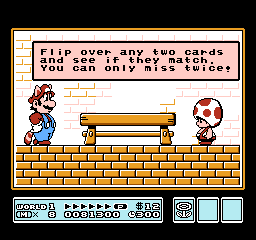 |
One of the most famous differences between the two US versions. Revision 0 is obviously grammatically wrong, as it should say "Miss twice and you're out!" As there is no more space in the text box to do that, the Revision 1 version simply reworded the sentence to fit it in. This change was carried to the European version. While All-Stars still used the incorrect PRG0 text, Advance 4's minigame cutscenes were completely redone, including a reformatted textbox, allowing it to use a grammatically correct version of the PRG0 text.
Princess's Letter
| US (Revision 0) | US (Revision 1)/Europe |
|---|---|
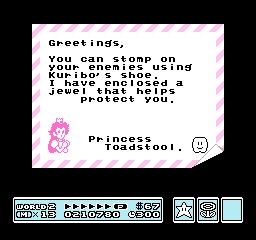 |
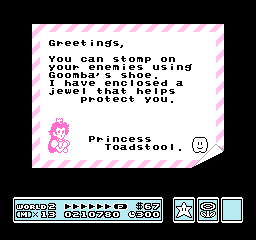 |
In Revision 0, the Princess talks about "Kuribo's Shoe". "Kuribo" is the Japanese name for Goomba, so whoever was translating the name didn't know that the enemy in question had its name changed for localization. In the Revision 1 version, it was renamed to Goomba's Shoe. Nintendo has had an unfortunate tendency to flip-flop between the two names in later games and publications (which later led to an originally unnamed Sockop (which resemble Goomba's Shoes) in Mario & Luigi: Bowser's Inside Story being given the name Kuribo in its western localization).
| Япония/США (Ревизия 0) | США (Ревизия 1)/Европа |
|---|---|
| Grass Land | Grass Land |
| Desert Hill | Desert Land |
| Ocean Side | Water Land |
| Big Island | Giant Land |
| The Sky | Sky Land |
| Iced Land | Ice Land |
| Pipe Maze | Pipe Land |
| Castle of Koopa | Dark Land |
Все именования миров (кроме Мира 1) в концовке были изменены. В японской и в оригинальной американской релизах миры имеют отчётливые наименования, которые позже были изменены на "____ Land".
Новые наименования не были внесены в All-Stars и Advance 4 где используются первоначальные наименования (однако "Ocean Side" был переименован в "Sea Side" и в Advance 4 Мир 8 также был переименован - "Castle of Koopa" в "Bowser's Castle").
Изменения "США-Европа"
Bowser's Letter
| US | Europe |
|---|---|
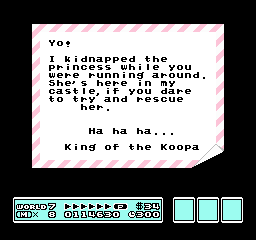 |
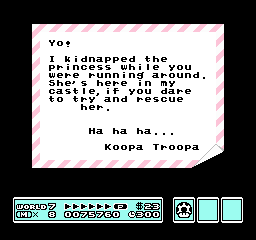 |
In the European version, the author of the letter has been inexplicably altered to "Koopa Troopa". Needless to say, this change was not carried over to All-Stars.
Virtual Console Changes
In the original game, the explosion of a Bob-Omb and collecting the "?" Orb dropped by Boom-Boom or the wand dropped by a Koopaling will cause the screen to flash a rainbow of colors. In the Virtual Console release, this was changed so that the screen merely turns bright yellow for a few seconds. This mirrors a change made in Advance 4 for similar reasons.
